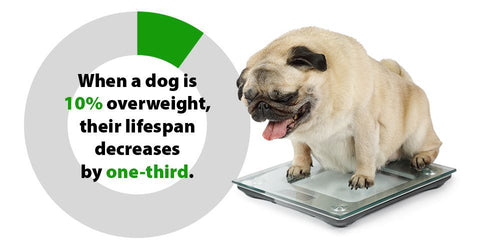
With fitness being a hot topic online, we often forget to discuss exercise and health when it comes to our pets. But when over half of pets in the United States are overweight, it’s something that we should talk about more often to promote healthy pets.

To recognize Canine Fitness Month, it should be shocking to know that about 54% of dogs in the U.S. are overweight. Unfortunately, when dogs have extra weight on them, they can face many health problems that can be detrimental. So, rather than allowing your beloved pup to live an unhealthy life, let’s dig into tips and advice for monitoring their health for their overall wellbeing.
Tracking Your Dog’s Health
The first thing to consider is your dog’s breed because each type of dog is different in terms of average, healthy weight. Every breed has an ideal healthy weight, so check out charts online to determine the range your dog should weigh. If your dog is a mixed breed, it’s best to ask your veterinarian about their healthy weight range.
Some breeds will weigh much more or less than others, so don’t assume your dog is an unhealthy weight if their body mass is different than other similar-sized dogs.
The Rib Test
So, what’s an easy way to tell if your dog could be overweight? One method to try is the “Rib Test,” where you stand behind your dog and gently run your hands along their rib cage. During this test, you should be able to feel each of your dog’s ribs.
Your dog should also have a noticeable waist or an area that tucks up in front of their hind legs. Then, gently pinch your dog’s skin. If you’re holding more than an inch of skin, your dog may be gaining weight.

Of course, every breed will have a different result in this test, so contact your veterinarian for a second opinion.
The Standing Test
Another test to conduct is the “Standing Test,” where you look at your dog’s profile view. Have them stand and look to see if they have body fat sagging down from their abdomen or stomach.
Next, stand above your dog and get a bird’s eye view of their overall appearance. Your dog’s chest should extend outwards with their waist making an hourglass shape, depending on the breed. The Standing Test is another general test to get an idea of your dog’s weight, but always consult your veterinarian as the next step.

The Dangers of Dogs Being Overweight
Like with people, there are many adverse health effects when dogs are overweight. For example, when dogs are even 10% overweight, their lifespan decreases by one-third and puts them at higher risk for heart, kidney, and liver disease. Other health risks include diabetes, arthritis, and cancer.

With cancer being the number one killer of dogs today, prevention is the best step forward. When dogs become overweight or obese, the blood vessels within the extra fat become inflamed. This combination can cause cancer cells to grow.
Even a few extra pounds in dogs can be more dangerous than humans gaining a little weight. For instance, a weight gain of just three pounds in a toy dog breed is equivalent to 30 pounds in humans.
How to Keep Your Dog Healthy
A balanced, healthy diet is the first step to keeping the extra pounds off of your dog. Although giving your dog food scraps is discouraged, a diet of fresh food like meats and vegetables will keep them healthy.
But, when giving your dog dry food, don’t follow the serving size recommendation on the bag. Why not? Isn’t the serving size the perfect amount? Not quite. Those serving sizes are determined by the average amount of food adult dogs of all breeds need.
So, these serving recommendations are more like suggestions, and often, they’re too much food for many dogs. You could be overfeeding your dog without realizing it because the serving sizes are too much food for your specific dog.
Although there are weight calculators online to find the correct amount of daily calories for your dog to consume, it’s always a best practice to consult your veterinarian on serving sizes.
But, for dogs of all sizes, healthy foods they can eat daily include lean meats like chicken, turkey, or fish. Dogs should also get plenty of fresh veggies like Brussels sprouts, cauliflower, broccoli, spinach, cabbage, and even kale!

Be mindful of how many you give your dog every day for snacks. For example, if you rely on dog biscuits for your dog’s only treats, try to switch some out for fresh veggies. Highly processed foods for dogs can be an underlying cause of your dog's weight gain.
Another critical factor that plays a role in your dog’s health is exercise. Regardless of size and breed, every dog should get at least 20 minutes of exercise twice a day. This exercise can include something as simple as going out for a 20-30 minute walk or exploring a hiking trail for a more extended time.

Even playing fetch outside will get your dog moving to lose the extra pounds, so you don’t have to develop a complicated workout routine. Getting your dog moving rather than becoming a couch potato will go a long way!
And there you have it, simple but effective ways to check up on your dog’s health. Remember to make an appointment with your dog’s veterinarian before implementing a diet and calorie intake change. We don’t want to go from overfeeding our dogs to underfeeding them by accident, so use these tips and tricks as guidelines until you get professional advice to help you maintain a healthy weight for your dog.



